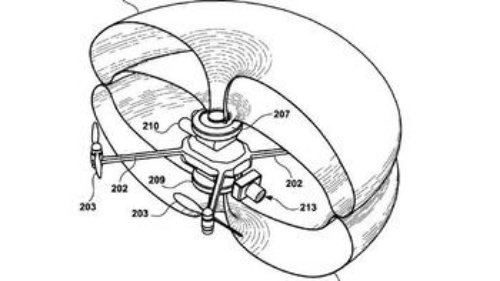
Sketch from Disney patent application shows airbag engulfing Disney drone. (Disney Enterprises patent application)
Disney is seeking patents for a unique new safety feature for its aerial drone light displays, according to a new patent application filed last Thursday by Disney Enterprises. An airbag has been designed to deploy around the drone, like giant bubble-wrap, if it malfunctions or if sensors detect an imminent collision with another object, the patent says.
Two airbags, on the bottom and top of each drone, would “engulf the entire frame structure and propulsion mechanism… to engulf the hard, sharp and spinning components of the UAV to reduce the effect of impact,” the patent says.
Basically, the airbags would become a bubble surround the entire drone and its propellers. The airbags would also “slow acceleration” in the event of a freefall, the patent says.
Disney has big plans for using drones in light displays at night. It is launching a show called “Starbright Holidays” for the Christmas season using 300 small flying drones to display Christmas trees, doves and holiday colors.
On Wednesday night, Disney showed a 5-minute demonstration of the show, over open water near Disney Springs shopping area. It was believed to be the first time a drone airshow of this scale was performed in the United States.
It’s not clear from the patent whether the drones used in Wednesday night’s demonstration have the airbags described in the patent application. Disney’s media office didn’t immediately respond a request for an interview about the airbags.
The FAA approved the shows, to be performed in areas where people aren’t standing below. In its application to the FAA, Disney said “flight paths will largely take place over water elements and restricted areas” and the drones, called Flixels, would max out at 150 feet above ground.
The drone described in the patent application has storage areas for the airbags. The airbag is “an inflation device coupled to the frame that receives an activation signal and inflates the one or more airbags, based upon receipt of the activation signal to deploy … prior to an impact of the frame with an object.”
The patent application says the airbags would get a signal to deploy if a device called an “accelerometer” detected that the drone was suddenly moving faster than it should be – in a free fall.
The patent application doesn’t specifically mention any possible threat to humans watching the shows. But it does say “As UAVs increasingly fly over locations where people are present, safety for those people is an important goal. Equipment malfunction, aerial hazards, and aerial maneuvers are examples of events which may result in a loss of propulsion.”
The document also says previous attempts at safety features have proven ineffective, such as parachutes that get caught in propellers, or electronic fences that malfunction.
The theme park giant is collaborating with Intel on its drone project.
Source: Orlando Sentinel
